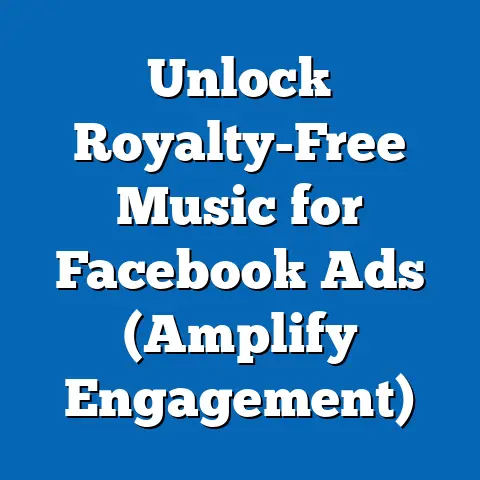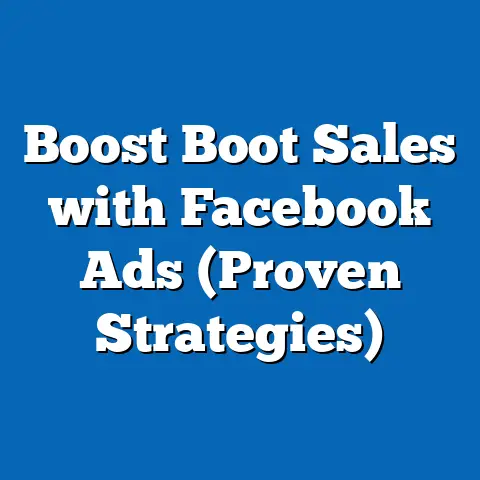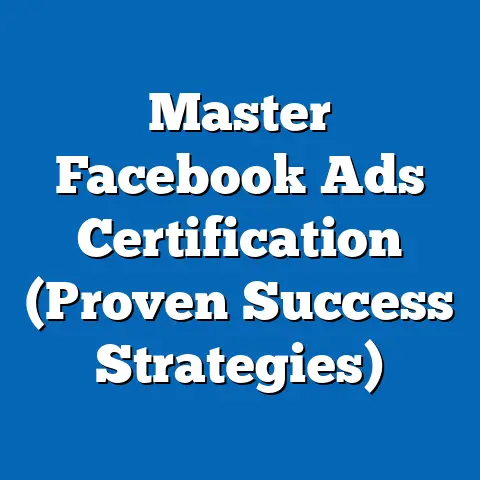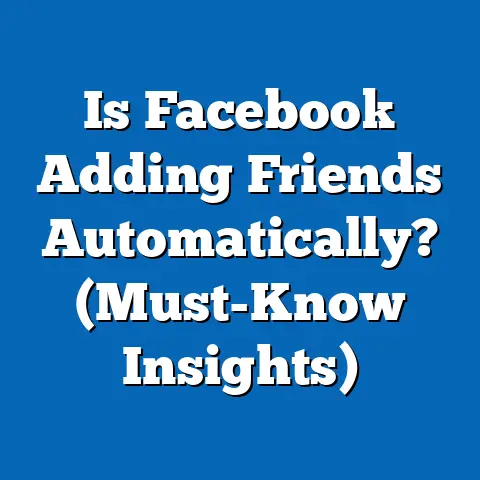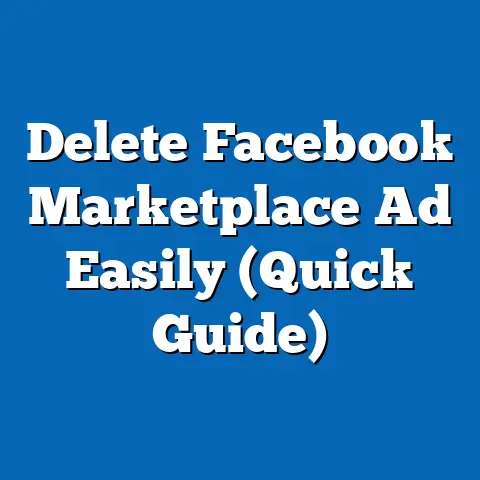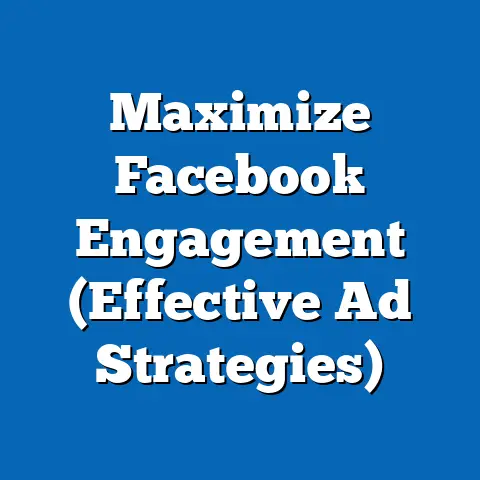Boost Sales with Automated Facebook Ads (Game-Changer)
In the ever-evolving world of digital marketing, one platform has remained a constant, a reliable workhorse for businesses of all sizes: Facebook. I’ve seen trends come and go, new platforms rise and fall, but Facebook, with its massive user base and sophisticated advertising tools, continues to deliver impressive results. It’s a place where small businesses can find their niche and large corporations can amplify their reach. But simply being on Facebook isn’t enough anymore. To truly unlock its potential and achieve a significant return on investment (ROI), businesses need to embrace the power of automation. I truly believe that automated Facebook ads are a game-changer, and in this article, I’m going to show you why.
Think of it this way: running Facebook ads manually is like driving a car with a stick shift in rush hour. You’re constantly shifting gears, adjusting your speed, and fighting for every inch of progress. Automation is like switching to an automatic transmission – suddenly, the ride becomes smoother, more efficient, and you can focus on the road ahead. This article will delve into how you can revolutionize your advertising strategy with automated Facebook ads, making your campaigns more efficient, more targeted, and ultimately, more profitable.
Understanding Facebook Ads
Facebook ads are, at their core, a powerful way for businesses to reach a specific audience on the world’s largest social media platform. It’s not just about throwing money at an ad and hoping for the best. It’s about strategically crafting messages that resonate with the right people at the right time. I’ve seen firsthand how a well-crafted Facebook ad can transform a struggling business into a thriving one.
There’s a diverse range of ad formats available, each with its own unique strengths:
- Image Ads: These are the simplest form of Facebook ads, featuring a single image and accompanying text. They’re great for showcasing products or services visually and are easy to create.
- Video Ads: Video ads are incredibly engaging and can be used to tell stories, demonstrate products, or share testimonials. I’ve found that video ads tend to have a higher click-through rate (CTR) than image ads, especially when the video is captivating from the first few seconds.
- Carousel Ads: Carousel ads allow you to showcase multiple images or videos in a single ad unit. This format is ideal for highlighting different features of a product, telling a story in sequence, or showcasing a range of products.
- Collection Ads: These ads are designed for e-commerce businesses and allow users to browse and purchase products directly from the ad. They typically feature a cover image or video, followed by a selection of related products.
- Lead Generation Ads: These ads make it easy for users to sign up for newsletters, request quotes, or provide their contact information directly within the Facebook platform. They’re perfect for building your email list and generating leads for your business.
One of the most impressive aspects of Facebook ads is its targeting capabilities. You can target users based on a wide range of factors, including:
- Demographics: Age, gender, location, education, relationship status, and more.
- Interests: Hobbies, passions, favorite brands, and topics they engage with on Facebook.
- Behaviors: Purchase history, online activity, device usage, and other behavioral patterns.
- Custom Audiences: You can upload your own customer lists or website visitor data to create custom audiences for retargeting or lookalike targeting.
- Lookalike Audiences: Facebook can create audiences that are similar to your existing customers or website visitors, allowing you to reach new people who are likely to be interested in your business.
The effectiveness of Facebook ads is well-documented. According to Statista, Facebook’s advertising revenue in 2023 was over $134 billion, showcasing the platform’s continued dominance in the digital advertising space. I’ve also seen numerous case studies where businesses have achieved significant ROI through Facebook ads. For example, a local restaurant increased its sales by 30% after implementing a targeted Facebook ad campaign that promoted its lunch specials to nearby residents.
Takeaway: Facebook ads are a versatile and powerful tool for reaching your target audience and driving sales. Understanding the different ad formats and targeting options is crucial for creating effective campaigns.
The Rise of Automation in Advertising
Automation has become a buzzword in the digital marketing world, and for good reason. It refers to the use of technology to automate repetitive tasks and processes, freeing up marketers to focus on more strategic initiatives. I’ve witnessed firsthand how automation can transform a chaotic marketing operation into a well-oiled machine.
In the context of advertising, automation can streamline various processes, including:
- Ad Creation: Automating the creation of ad copy, images, and videos based on predefined templates and data feeds.
- Audience Targeting: Automatically identifying and targeting the most relevant audiences based on real-time data and machine learning algorithms.
- Budget Optimization: Automatically adjusting bids and budgets to maximize ROI based on performance data.
- A/B Testing: Automating the process of testing different ad variations to identify the most effective combinations.
- Reporting and Analytics: Automatically generating reports and dashboards to track key performance indicators (KPIs) and identify areas for improvement.
Automation tools can significantly improve efficiency by reducing manual effort and minimizing the risk of human error. They can also enhance targeting precision by leveraging real-time data and machine learning algorithms to identify the most relevant audiences. As a result, businesses can achieve a higher ROI on their advertising investments.
Successful automated campaigns can be found across various platforms. For example, Google Ads offers features like Smart Bidding, which automatically adjusts bids based on the likelihood of a conversion. Email marketing platforms like Mailchimp and Klaviyo allow you to automate email sequences based on user behavior and preferences. These examples demonstrate the power of automation in driving results across different marketing channels.
One common misconception about automation is that it leads to a lack of personalization. However, I’ve found that the opposite is often true. Automation can actually enhance personalization by allowing you to deliver the right message to the right person at the right time, based on their individual needs and preferences. For example, you can use dynamic ads to show personalized product recommendations to users based on their browsing history.
Takeaway: Automation is a powerful tool for streamlining advertising processes, improving efficiency, and enhancing personalization. Don’t let misconceptions hold you back from exploring the potential of automation in your marketing efforts.
How Automated Facebook Ads Work
Setting up automated Facebook ads involves leveraging the tools and features available within Facebook Ads Manager, as well as potentially integrating with third-party automation software. I’ve spent countless hours experimenting with different automation strategies, and I’ve learned that a strategic approach is key to success.
The process typically involves the following steps:
- Define Your Goals: Start by clearly defining what you want to achieve with your automated Facebook ads. Are you looking to generate leads, drive sales, increase brand awareness, or something else? Your goals will guide your targeting, messaging, and budget allocation.
- Select Your Target Audience: Use Facebook’s targeting options to identify the most relevant audience for your ads. Consider demographics, interests, behaviors, and custom audiences.
- Create Your Ad Campaign: Within Ads Manager, create a new ad campaign and select your desired objective (e.g., conversions, lead generation, traffic).
- Choose Your Ad Format: Select the ad format that best suits your message and target audience. Consider image ads, video ads, carousel ads, or collection ads.
- Craft Your Ad Copy and Visuals: Create compelling ad copy and visuals that grab attention and resonate with your target audience. Make sure your message is clear, concise, and relevant.
- Set Your Budget and Bidding Strategy: Determine your daily or lifetime budget and choose a bidding strategy that aligns with your goals. Facebook offers various bidding options, including cost per click (CPC), cost per impression (CPM), and cost per acquisition (CPA).
- Implement Automated Rules: Use Facebook’s Automated Rules feature to automatically adjust your bids, budgets, and ad schedules based on performance data. For example, you can set up a rule to automatically increase your bids when your ads are performing well and decrease them when they’re underperforming.
- Utilize Dynamic Ads: If you’re an e-commerce business, leverage Dynamic Ads to show personalized product recommendations to users based on their browsing history. This can significantly increase your conversion rates.
- Run A/B Tests: Continuously test different ad variations to identify the most effective combinations. Facebook Ads Manager makes it easy to run A/B tests on your ad copy, visuals, targeting, and bidding strategies.
- Monitor and Optimize: Regularly monitor your ad performance and make adjustments as needed. Use Facebook Analytics to track key metrics like impressions, clicks, conversions, and ROI.
Features like Dynamic Ads, Automated Rules, and A/B Testing are integral to automation on Facebook. Dynamic Ads allow you to personalize your ads based on user behavior, while Automated Rules help you optimize your campaigns in real-time. A/B Testing allows you to continuously improve your ads by testing different variations.
Configuring an automated Facebook ads campaign is surprisingly user-friendly. Facebook Ads Manager provides a step-by-step interface that guides you through the process. I recommend starting with a small budget and gradually scaling up as you see positive results.
Takeaway: Setting up automated Facebook ads involves a strategic approach that leverages Facebook’s built-in tools and features. By defining your goals, selecting the right audience, and implementing automated rules, you can create highly effective campaigns that drive results.
The Advantages of Automated Facebook Ads
The benefits of using automated Facebook ads are numerous and can have a significant impact on your business. I’ve seen firsthand how automation can transform a struggling advertising campaign into a high-performing one.
Here are some of the key advantages:
- Time Savings: Automation can free up a significant amount of time by automating repetitive tasks like ad creation, budget optimization, and reporting. This allows you to focus on more strategic initiatives, such as developing new marketing strategies or improving your product offerings.
- Improved Targeting Precision: Automation tools can leverage real-time data and machine learning algorithms to identify the most relevant audiences for your ads. This can lead to higher click-through rates (CTRs) and conversion rates.
- Enhanced ROI: By improving targeting precision and optimizing your bids and budgets, automation can help you achieve a higher ROI on your advertising investments.
- Consistent Ad Performance: Automation can help you maintain consistent ad performance by automatically adjusting your campaigns based on real-time data. This ensures that your ads are always performing at their best.
- Quicker Adjustments: Automation allows you to make quicker adjustments to your campaigns based on real-time data. This is especially important in today’s fast-paced digital landscape, where trends can change quickly.
- Effortless Scaling: Automation makes it easy to scale your advertising efforts without significantly increasing your workload. This allows you to reach larger audiences and drive more sales without having to spend more time managing your campaigns.
One of the most significant benefits of automation is the ability to scale your advertising efforts effortlessly. I’ve seen businesses that were previously limited by their manual processes suddenly able to reach a much larger audience after implementing automation. This can lead to exponential growth in sales and revenue.
Many business owners have successfully integrated automation into their Facebook advertising strategies. For example, Sarah, the owner of a small online clothing boutique, was struggling to manage her Facebook ads manually. After implementing automated rules and dynamic ads, she saw a 50% increase in sales and a significant reduction in the time she spent managing her campaigns.
Takeaway: Automated Facebook ads offer a wide range of benefits, including time savings, improved targeting precision, enhanced ROI, consistent ad performance, quicker adjustments, and effortless scaling. By embracing automation, you can unlock the full potential of Facebook advertising and drive significant growth for your business.
Real-World Case Studies
To illustrate the power of automated Facebook ads, let’s take a look at some real-world case studies:
- E-commerce Business: An online retailer selling handmade jewelry implemented dynamic ads on Facebook, showcasing personalized product recommendations to users based on their browsing history. As a result, they saw a 30% increase in conversion rates and a 20% increase in average order value.
- Local Business: A local pizza restaurant used Facebook’s Automated Rules feature to automatically increase their bids during peak hours (e.g., lunch and dinner) and decrease them during off-peak hours. This resulted in a 15% increase in sales and a significant reduction in their advertising costs.
- B2B Service: A B2B software company used Facebook’s lead generation ads and automated email sequences to generate qualified leads for their sales team. They saw a 40% increase in lead generation and a significant improvement in the quality of their leads.
These case studies highlight the versatility of automated Facebook ads across different industries. Whether you’re an e-commerce business, a local business, or a B2B service provider, automation can help you achieve your advertising goals.
The strategies employed in these case studies included:
- Personalized Product Recommendations: Using dynamic ads to show personalized product recommendations to users based on their browsing history.
- Automated Bidding Strategies: Using Facebook’s Automated Rules feature to automatically adjust bids based on performance data and time of day.
- Lead Generation and Email Automation: Using Facebook’s lead generation ads and automated email sequences to generate and nurture leads.
The challenges faced in these case studies included:
- Setting Up Automated Rules: Configuring automated rules can be complex and requires a good understanding of Facebook Ads Manager.
- Monitoring Ad Performance: Regularly monitoring ad performance and making adjustments as needed is crucial for success.
- Ensuring Data Accuracy: Accurate data is essential for effective automation. Make sure your tracking pixels and analytics are set up correctly.
The results achieved in these case studies included:
- Increased Conversion Rates: Implementing dynamic ads led to a significant increase in conversion rates.
- Reduced Advertising Costs: Using automated bidding strategies led to a reduction in advertising costs.
- Improved Lead Generation: Using lead generation ads and automated email sequences led to an increase in lead generation and lead quality.
Key Takeaways:
- Automated Facebook ads can be highly effective across different industries.
- Personalization, automated bidding strategies, and lead generation are key strategies for success.
- Setting up automated rules, monitoring ad performance, and ensuring data accuracy are crucial challenges to overcome.
Takeaway: Real-world case studies demonstrate the power of automated Facebook ads in driving results for businesses of all sizes. By learning from these examples, you can apply similar strategies to your own advertising efforts and achieve significant growth.
Conclusion
In conclusion, adopting automated Facebook ads is no longer a luxury but a necessity for businesses aiming to thrive in today’s competitive digital marketing landscape. I’ve seen firsthand how automation can transform advertising campaigns, making them more efficient, more targeted, and ultimately, more profitable.
The game-changing potential of automation lies in its ability to streamline processes, improve targeting precision, and enhance ROI. By leveraging the tools and features available within Facebook Ads Manager, as well as potentially integrating with third-party automation software, you can create highly effective campaigns that drive results.
I encourage you to explore the various automation options available and consider the long-term benefits of staying ahead in the digital marketing game. Don’t be afraid to experiment with different strategies and see what works best for your business. The future of Facebook advertising is undoubtedly automated, and by embracing this trend, you can position your business for long-term success.
Remember, the key to successful automation is a strategic approach that starts with clearly defined goals and a deep understanding of your target audience. By combining your marketing expertise with the power of automation, you can unlock the full potential of Facebook advertising and achieve significant growth for your business.

